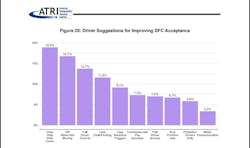ATRI identifies ways carriers can improve driver-facing camera approval
In-cab, driver-facing cameras appeal to fleet safety managers and trucking insurance providers for obvious safety reasons. That said, driver-facing cameras still are not fully utilized across the entire industry, according to new research from the American Transportation Research Institute.
Driver privacy, confusion over video use, and highlighting potential driver negligence are the top concerns deterring that widespread adoption, according to ATRI’s latest report.
The report “Issues and opportunities with driver-facing cameras” investigates industry attitudes and concerns toward driver-facing and road-facing cameras. The research identified points of consensus and potential compromise on in-cab camera systems and policies among truck drivers, motor carriers, legal experts, and insurers. Based on the analysis, ATRI has proposed strategies for improving both driver approval and camera utilization.
See also: How dash cams, driver coaching tools could help fleets reduce costs
“Driver-facing cameras are an important safety tool for carriers, but they must be managed carefully in order to leverage benefits with drivers, insurers, and attorneys,” said Jerry Sigmon, chief operating officer for Cargo Transporters (No. 236 on the FleetOwner 500 For-Hire list), said in an ATRI press release. “ATRI’s research on in-cab cameras provides an important blueprint for both carriers using these technologies as well as carriers still contemplating the investment.”
Driver approval of driver-facing cameras tends to be low—just 2.24 on a zero-to-10 scale among 650 current users across the industry. Low scores are partly driven by limited experience, confusion over various camera systems, unclear carrier policies, and strong privacy concerns.
Women rated the protection of their privacy with driver-facing cameras onboard 34% lower than men. Several female drivers in ATRI’s survey complained that they had experienced voyeurism, unwanted comments about their appearance, and sexual harassment from employees tasked with reviewing driver-facing camera footage, according to the report.
See also: Women underscore ongoing harassment, driver training problems in trucking
Nevertheless, the report identified carrier policies and driver management approaches leading to higher driver ratings. Overall, driver approval of driver-facing cameras increased by 87% when carriers used video footage for specific proactive safety measures.
Additional analyses focus on insurance and litigation considerations for in-cab cameras. Experts in both fields preferred event-based driver-facing cameras over continuously recording cameras, and they concurred with drivers that primary video footage access should be limited to safety managers as much as possible.
Drivers suggest ways to improve acceptance
In its driver survey, ATRI also asked respondents to share suggestions on improving the acceptance of driver-facing cameras. Most respondents—77.5%--did not provide suggestions. However, the remainder shared constructive criticism, including the following:
View footage only after crashes
The most common truck driver suggestion was that carriers should use footage only as evidence in legal contexts and not for any coaching purpose or internal evaluation.
Keep cameras off when the truck is not moving
Drivers indicated that cameras should never be on when the driver is off-duty, on break, or any time the truck is parked. According to the report, numerous drivers described experiences in which carriers questioned them about events recorded by the cameras when the driver was off-duty.
Provide full driver control
According to the research, “Opinions in this category take two approaches: drivers would get to decide when the camera is on or have full discretion over whether to grant carriers access to view footage. The second option would give drivers strong incentive to grant access after an incident only when it shows that the truck driver was not negligent, but it is unlikely that a carrier would implement this suggestion due to liability concerns, or accusations of spoliation of evidence.”
Avoid fault-seeking
Here, drivers called out managers for “nitpicking” and “micromanaging.” ATRI provided other ways that carriers can respond to these types of complaints. For example, ATRI suggested that carriers should act on camera footage more selectively by focusing coaching programs on significant or recurring behaviors and passing over minor or isolated behaviors to avoid the impression of redundancy and fault-seeking. “Emphasis should be placed on outcomes rather than behaviors alone, as well as issues that offer the opportunity for genuine skill growth,” according to the research. “Based on comments, this counterproductive coaching can be worse than no coaching at all if it leads drivers to disregard safety policies and good driving behavior.”
Fewer sensitive triggers
More than 9% of truck drivers reported that event-based cameras are too sensitive, adding that significant safety events should only activate cameras.
Add pay increase
According to the research, 7.3% of truck drivers report that a pay increase for drivers using these cameras would “make them more amenable” to the technology, even without changing a carrier’s camera policy.
Provide better communication
“Based on binned truck driver responses, the most easily implemented driver suggestion for improving driver acceptance of driver-facing cameras was to communicate use, policies, and procedures clearly and transparently; 3.3% said that addressing this issue alone would improve acceptance,” according to ATRI.
A full copy of ATRI’s report is available to download.
About the Author
FleetOwner Staff
Our Editorial Team
Kevin Jones, Editorial Director, Commercial Vehicle Group
Josh Fisher, Editor-in-Chief
Jade Brasher, Senior Editor
Jeremy Wolfe, Editor
Jenna Hume, Digital Editor
Eric Van Egeren, Art Director

